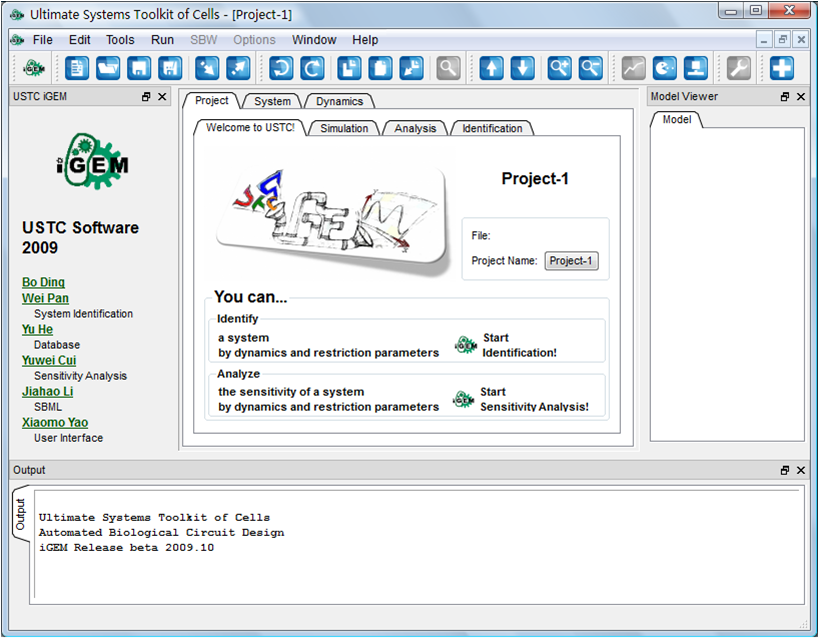Team:USTC Software/WhatOverview
From 2009.igem.org
(→Platform) |
|||
| (3 intermediate revisions not shown) | |||
| Line 13: | Line 13: | ||
| | | | ||
==Goal== | ==Goal== | ||
| + | |||
| + | [[Image:Db_wk6.png|right|180x553px|thumb|Work Flow]] | ||
The ultimate goal of our program is to assist the experimentalists to design the plasmid that works as the requirement. For example, if an oscillation behavior is the requirement as the input of the software, then the output in our imagination is a DNA sequence which works as an oscillator in E.coli or other specific organisms. It is only an imagination that we have a long way to go. Then the first goal is to make a network work stably. Generally, the desired phenotype is the input of the software, and, optionally, the restrictions extracted from the other experiments or conditions can be the input simultaneously. And the output is a list of networks that have similar phenotypes approximating to the requirement, along with the kinetic parameters and robustness evaluation. | The ultimate goal of our program is to assist the experimentalists to design the plasmid that works as the requirement. For example, if an oscillation behavior is the requirement as the input of the software, then the output in our imagination is a DNA sequence which works as an oscillator in E.coli or other specific organisms. It is only an imagination that we have a long way to go. Then the first goal is to make a network work stably. Generally, the desired phenotype is the input of the software, and, optionally, the restrictions extracted from the other experiments or conditions can be the input simultaneously. And the output is a list of networks that have similar phenotypes approximating to the requirement, along with the kinetic parameters and robustness evaluation. | ||
| Line 18: | Line 20: | ||
==Work Flow== | ==Work Flow== | ||
| - | The three-layer optimization is expected during the whole design process: (1) the optimization of parameters in a fixed mathematic model, (2) the selection of interaction forms in a fixed topology, (3) the comparison and screening of different topologies. And during the optimization of the parameters, there are two | + | The three-layer optimization is expected during the whole design process: (1) the optimization of parameters in a fixed mathematic model, (2) the selection of interaction forms in a fixed topology, (3) the comparison and screening of different topologies. And during the optimization of the parameters, there are two ''score functions'' considered. One is the RMSD(root mean square deviation) between the phenotype of the designed network and the requirement, and the other is the sensitivity of each parameter. As the cell system is noisy, the networks are hard to realize in experiments if some parameters are too sensitive to uncertainties. So the parameters' sensitivities are working as a filter to get rid of the networks that works not stably enough. After the three-layer's optimization and comparison, a list of the best selected networks will output as the final solutions. |
==Platform== | ==Platform== | ||
| + | [[Image:Yxm8.png|center|400px|thumb|GUI Sample]] | ||
A user-friendly network-design platform is realized in our software with C# for the experimentalists. The interface is shown in Figure2.Users can input the requirement curves with uploading a data file. And the picture files for curves are also supported by our software. And the network can be designed by manually drawing the species and the interactions. The phenotypes of the designed networks will be shown with graphs that users can directly see the performances of the results and the deviation between the results and the requirement. | A user-friendly network-design platform is realized in our software with C# for the experimentalists. The interface is shown in Figure2.Users can input the requirement curves with uploading a data file. And the picture files for curves are also supported by our software. And the network can be designed by manually drawing the species and the interactions. The phenotypes of the designed networks will be shown with graphs that users can directly see the performances of the results and the deviation between the results and the requirement. | ||
Latest revision as of 02:48, 22 October 2009
| About | Team and People | Project | Standard | Notebook | Demo | Safety | External Links |
|---|
|
|
Project Overview
|
|
 "
"






























